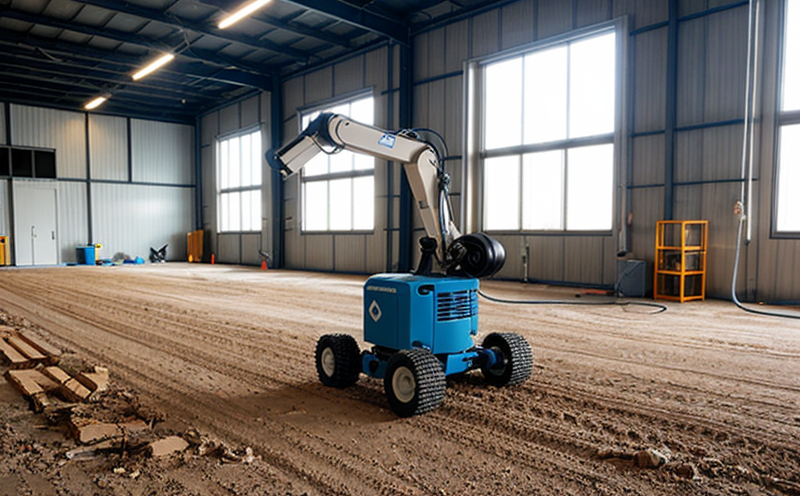MIL-STD-810H Sand and Dust Exposure Testing for Robotics
The Military Standard MIL-STD-810H is a comprehensive document that addresses environmental conditions under which military equipment, including robotics and artificial intelligence (AI) systems, must operate successfully. One of the critical tests within this standard is sand and dust exposure testing. This test evaluates how well robotic systems perform in environments with high levels of particulate matter such as sand, dust, or similar materials.
This type of environmental stress can be particularly challenging for robotics due to the intricate nature of their mechanical components and electronic circuits. Sand and dust particles can easily infiltrate these delicate parts, leading to malfunctions or complete system failures. Therefore, it is essential for manufacturers and developers to ensure that their robotic systems meet rigorous testing standards before deployment.
The test simulates real-world conditions where the robot might be subjected to harsh environmental factors. These could include desert or arid regions, construction sites, disaster relief operations, or other environments characterized by high particulate content in the air. By undergoing this stringent test regimen, manufacturers can gain confidence that their products will perform reliably under such challenging circumstances.
During the sand and dust exposure testing process, the robot is placed inside an environmental chamber where controlled levels of sand and dust are introduced into the atmosphere. The intensity and duration of these exposures are specified according to the requirements outlined in MIL-STD-810H. After each test run, engineers carefully examine the robotic unit for any signs of damage or degradation.
The testing procedure includes several stages designed to evaluate different aspects of the robot's design and construction. These stages may involve assessing the integrity of seals and gaskets used around joints and openings; examining surface finishes for evidence of abrasion; checking electrical connections for continuity; verifying operational parameters like speed, accuracy, and repeatability; and ensuring that all sensors function correctly.
It is important to note that while MIL-STD-810H provides a framework for conducting sand and dust exposure tests, specific procedures can vary depending on the type of robotic system being tested. For instance, wheeled robots might require additional considerations regarding wheel traction compared to legged robots which need evaluation based on their locomotion capabilities.
By adhering strictly to MIL-STD-810H guidelines during this critical phase of product development and quality assurance, manufacturers can significantly reduce the risk of field failures and enhance customer satisfaction. Furthermore, successful completion of these tests often leads to better market acceptance since buyers appreciate products proven capable of handling demanding operational environments.
To summarize, MIL-STD-810H sand and dust exposure testing plays a vital role in ensuring that robotics and AI systems are robust enough to function effectively in various challenging scenarios. Through meticulous evaluation under controlled conditions, manufacturers can identify potential weaknesses early on and implement improvements accordingly. Ultimately, this ensures not only compliance with industry standards but also enhances overall product reliability.
Applied Standards
| Standard Reference | Description |
|---|---|
| MIL-STD-810H, Method 506.7 | This method specifies procedures for determining the effects of sand and dust on electronic equipment, including robotics systems. |
| IEC 60529 IP Ratings | Provides additional information regarding ingress protection ratings which are relevant when considering environmental resistance in robotic designs. |
Why Choose This Test
- Ensures robust performance of robotic systems in harsh environments.
- Identifies potential weaknesses early to implement necessary improvements.
- Enhances overall product reliability and customer satisfaction.
- Promotes market acceptance by demonstrating capability to handle demanding operational conditions.
- Aids in compliance with industry standards and regulations.
Customer Impact and Satisfaction
The success of MIL-STD-810H sand and dust exposure testing directly impacts customer satisfaction. When robotic systems undergo thorough environmental stress tests, customers receive products that are proven capable of functioning effectively even under extreme conditions. This not only builds trust but also enhances reputation among end-users.
Moreover, by ensuring compliance with rigorous international standards like MIL-STD-810H, manufacturers demonstrate their commitment to quality and reliability. Such adherence often translates into better acceptance from buyers who value robust solutions that can withstand harsh operating environments.
In summary, the benefits of choosing this test extend beyond mere regulatory fulfillment; they contribute significantly towards enhancing customer satisfaction by delivering high-quality products designed for optimal performance in demanding situations.





